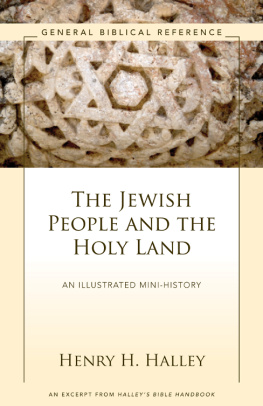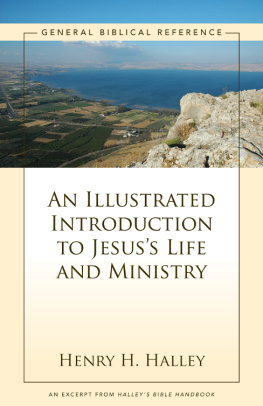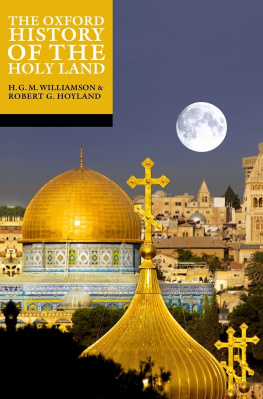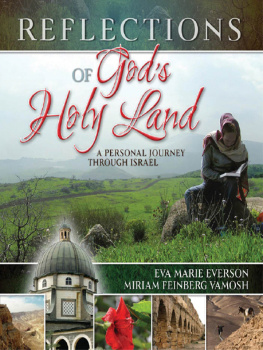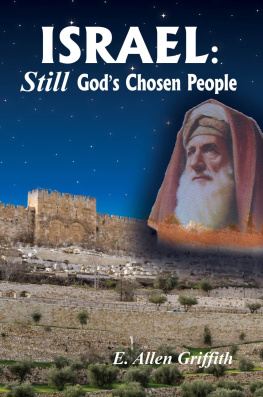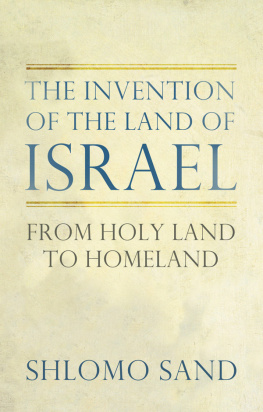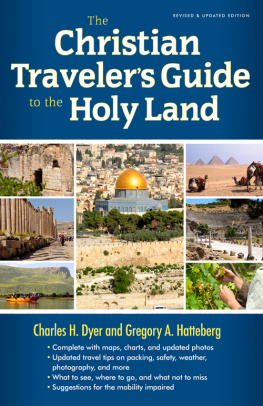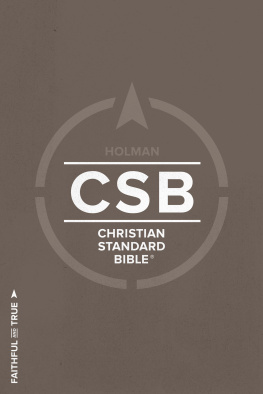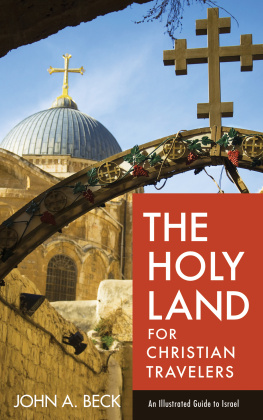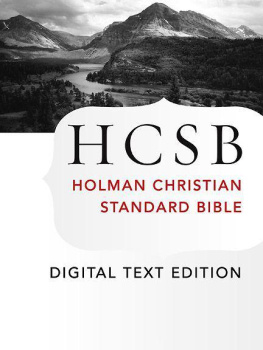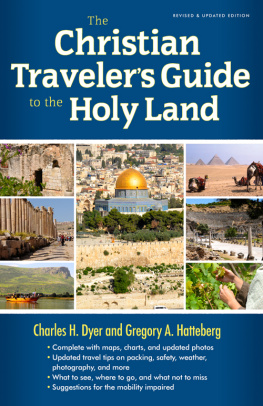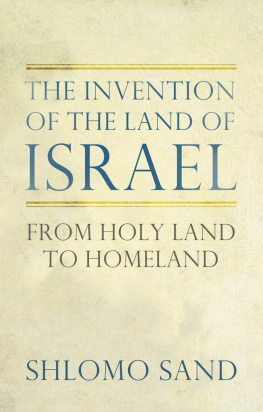ZONDERVAN
The Jewish People and the Holy Land
Copyright 2000, 2007 by Halleys Bible Handbook, Inc.
Previously published in Halley's Bible Handbook with the New International VersionDeluxe Edition
All rights reserved under International and Pan-American Copyright Conventions. By payment of the required fees, you have been granted the non-exclusive, non-transferable right to access and read the text of this e-book on-screen. No part of this text may be reproduced, transmitted, downloaded, decompiled, reverse engineered, or stored in or introduced into any information storage and retrieval system, in any form or by any means, whether electronic or mechanical, now known or hereinafter invented, without the express written permission of Zondervan.
ePub Edition August 2012: ISBN 978-0-310-49627-4
Requests for information should be addressed to:
Zondervan, Grand Rapids, Michigan 49530
The Library of Congress has cataloged the complete volume as:
Halley, Henry Hampton, 1874 1965.
Halleys Bible handbook with the New International Version / by Henry H. Halley.
p. cm.
Includes bibliographical references and index.
ISBN 978-0-310-22479-2 (hardcover)
1. BibleCommentaries. I. Title.
BS491.2.H355 2000
220.77dc 021 99-059615
All Scripture quotations, unless otherwise indicated, are taken from The Holy Bible, New International Version. NIV. Copyright 1973, 1978, 1984 by International Bible Society. Used by permission. All rights reserved worldwide.
Any Internet addresses (websites, blogs, etc.) and telephone numbers in this ebook are offered as a resource. They are not intended in any way to be or imply an endorsement by Zondervan, nor does Zondervan vouch for the content of these sites and numbers for the life of this book.
All rights reserved. No part of this publication may be reproduced, stored in a retrieval system, or transmitted in any form or by any means--electronic, mechanical, photocopy, recording, or any other--except for brief quotations in printed reviews, without the prior permission of the publisher.
Cover design: Ron Huizinga
Why Is This Important?
Two of Gods promises to Abraham were that his descendants would become a large nation and that they would live in the land that God promised him. The Jewish people and the Promised Land play key roles in the biblical narratives. But there is generally a gap of almost 2000 years in our awareness of the story of the Promised Land and the Jews, Gods covenant peoplea gap from the end of the book of Acts, where clear delineation occurs between Judaism and Christianity, to the founding of the State of Israel in 1948, which marks the fulfillment of many prophecies regarding the regathering of Jews in Israel (see Ezekiel 37:3, 711, 2123; Matthew 24:3234).
During this significant historical gap, Christianity grew from a small Jewish sect into a world religion; Islam was founded and became a major religious and political force. The histories of the three major monotheistic world religionsJudaism, Christianity, and Islambecame intertwined. The Promised Land was under Islamic control for almost 1,300 years. The Jews have been persecuted for many centuries, sadly mostly in countries that considered themselves to be Christian.
The story of the land and the Jewish people from the end of Acts to the present shows how incredible it is that the Jews have survived and once again live in the land, albeit seemingly somewhat precariously at times. It is difficult not to see Gods hand at work through all of this. The history of Gods dealings with His people Israel did not end with the Bible but has continued and continues today. This should not surprise us, for God promised that He would regather and restore the Jews in the end times.
The Jews and Palestine in the First Two Centuries A.D.
During most of the last 2,500 years, from the Babylonian exile through the New Testament era to the present, the majority of Jews have lived outside the land that God had given them. It was not until 1948 that Jews were able to return to Israel in large numbers and take political, economic, and social control of at least part of the land.
During these 21/2 millennia, the Jews have achieved the impossible: they have kept their religious and ethnic identity and culture alive, in spite of (and often because of) persecutions and attempts to eradicate them. What enabled them to do this is, in part, that they have celebrated and retold their biblical history and heritage on each Sabbath, especially on feasts such as the Passover, and on holy days such as Yom Kippur, the Day of Atonement.
The Early Diaspora (Dispersion or Scattering)
In 586 B.C., Nebuchadnezzar destroyed Jerusalem and took most of the Jewish population to Babylonia. The Babylonian exile officially came to an end 50 years later, when King Darius of Persia allowed the Jews to return to Jerusalem and to rebuild the temple under Ezra and Zerubbabel.
Many Jews chose to remain in Babylonia, however, where Jewish communities flourished. Later, during the Greek period that followed the conquests of Alexander the Great (around 330 B.C.), many Jews voluntarily settled elsewhere outside Palestine. By the time of Christ, some 4 million Jews lived in the Roman Empire and constituted about 7 percent of the empires total population. Of these 4 million, less than 20 percent lived in Palestine (about 700,000). There were, in fact, more Jews in Alexandria, Egypt, than in Jerusalem, and in some parts of Palestine, Gentiles outnumbered Jews.
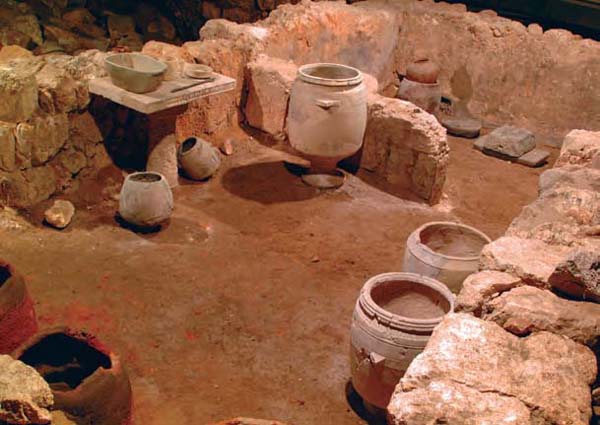
The remains of this 1st-century Jerusalem house is evidence that Romes response to the first Jewish revolt led to the destruction of the temple and precipitated major Jewish Diaspora.
When the church began on the Day of Pentecost, Jews from all over the Roman Empire were in Jerusalem. They spoke a variety of languages, and it is likely that many did not speak Aramaic (then the common language in the Near East) at all. On his missionary travels Paul found a synagogue in nearly every city he visited. An exception was Philippi, where there was merely a place of prayer by the river, where a group of women gathered.
The First Revolt
During the life of Jesus, Palestine had been uncharacteristically quiet. The Roman historian Tacitus, speaking of Palestine under Emperor Tiberius (A.D. 1437), says, almost with a sigh of relief, Peace under Tiberius! But it was not to last.
The rebuilding and beautifying of the temple in Jerusalem, begun by Herod the Great in 20 B.C., was finally completed in A.D. 64sixty years after Herods death. A mere two years later, the Zealots, a fanatical Jewish sect, instigated a violent insurrection against Rome. In A.D. 70 the revolt was crushed, and Jerusalem and the temple were destroyed.
The last fortress of the revolutionaries was Masada, a massive, flat-topped rock near the Dead Sea. Herod had built palaces on Masada, choosing the location in large part because it was easy to defend, with steep slopes on all sides. The Roman army laid siege to Masada in A.D. 70. They built a campthe remains of which are still visibleand spent several frustrating years attacking the mountain with catapults and other war machines. Finally, the Romans decided on the only strategy left: they constructed a massive earthen ramp up the side of the mountain until they were able to walk to the top.
The Second Revolt
After this, Judea was once again relatively peaceful for about 60 years. But then Emperor Hadrian (A.D. 117138) decided to rebuild Jerusalem as a pagan city, to be named Aelia Capitolina, in honor of Jupiter, the chief god of the Romans. He also banned circumcision, which for two millennia had been the indelible mark of Jewishness.

